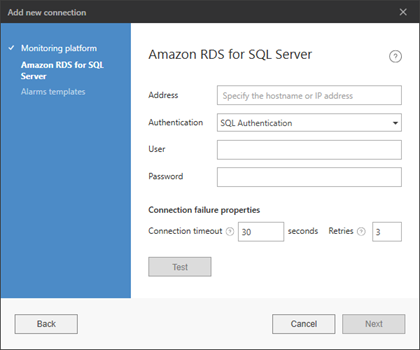Check your Amazon RDS for SQL Server instances fulfills the requirements of Spotlight Cloud.
Connection details
Open this dialog in the Spotlight Cloud Diagnostic Server application. Show me how to open the connection details screen in the Spotlight Cloud Diagnostic Server application.
Scroll down this help page for information specific to Amazon RDS for SQL Server.

Amazon RDS for SQL Server address
Specify the fully qualified server name used to link to the Amazon RDS for SQL Server instance.
If aliases are used then an incorrect alias on the client machine can cause connections to fail. Check the alias name of the instance.
Authentication
Use SQL authentication to authenticate access to the Amazon RDS for SQL Server instance.
Fill in the database User and Password fields. Ensure the database user has sufficient account permissions to retrieve performance data from the Amazon RDS for SQL Server instance. Typically the account will be a Master login that was created via the RDS instance creation. If this is not feasible in your environment, see How to grant SQL Server account permissions to a trusted user.
The connection will fail if the account permissions are insufficient to allow Spotlight Cloud to collect the data it needs.
Connection failure properties
Set the connection timeout and the number of times Spotlight should attempt to connect to the Amazon RDS for SQL Server before raising the connection failure alarm.
If the number of times Spotlight should attempt to connect to the Amazon RDS for SQL Server instance before raising an alarm is greater than 9 then type that number into the given field.
Alarms template: template
Select the alarms configuration template to apply to this connection or select Factory Settings Template to apply the factory settings shipped with Spotlight Cloud. Select from any of the Amazon RDS for SQL Server configuration templates that you have created through configure alarms.
The alarms template option is applicable only when creating a new Amazon RDS for SQL Server instance. To apply a template to an existing Amazon RDS for SQL Server connection, see configuration templates.
Testing the connection
When you add a new Amazon RDS for SQL Server connection or edit the details of an existing connection, Spotlight Cloud tests its ability to connect.
Connection failure
If Spotlight Cloud fails to connect to the Amazon RDS for SQL Server then you may want to return to the connection details dialog to ensure the details you have entered are correct. You may want to troubleshoot Amazon RDS for SQL Server connection failure.
Saving a failed connection
Spotlight Cloud does allow you to save the connection details to a Amazon RDS for SQL Server that it has failed to connect to. If you do save the connection and Spotlight Cloud cannot connect to it then Spotlight Cloud will raise a connection failure alarm. Spotlight Cloud will re-try to connect every 30 seconds until successful. This could be a problem if associated services lock you out after a limited number of failed attempts. To clear the connection failure alarm, wait until Spotlight Cloud successfully connects (when Spotlight Cloud shows collected data). Then acknowledge the alarm.
There are things you can do to change Spotlight Cloud default behavior. You may want Spotlight Cloud to wait for a future occasion to monitor the connection rather than monitoring it right away. The simplest way to do that is to disable the connection. Spotlight Cloud will stop monitoring it. Spotlight Cloud will monitor the connection again when you enable it. See enable/disable.
Note that Spotlight Cloud automatically disables all connections added above your subscription quota.
Other features you may want to use if you save a failed connection are planned outage where you can delay monitoring of the connection till a specified time. You can create an alarm action rule to notify changes in status for an enabled connection.